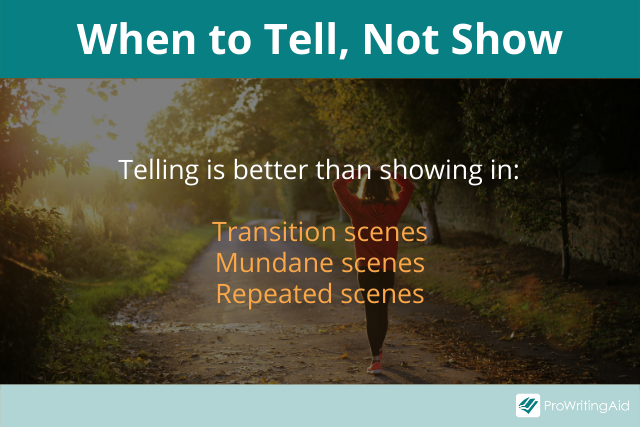
“Show, don’t tell” is a piece of writing advice that almost every writer has heard before.
So, what exactly does this phrase mean, and do you really need to follow it?
The short answer is that “showing” paints a picture in the reader’s mind, while “telling” simply states what happened.
This article will explain the difference between showing and telling and demonstrate how to use this technique in your own writing.
- Quick Definition and Meaning of “Show, Don’t Tell”
- What Are the Benefits of Show vs Tell in Writing?
- Examples of Showing vs Telling in Writing
- Examples of “Show, Don’t Tell” in Popular Novels
- How to Show Not Tell in Writing: Four Expert Tips
- Is Telling Ever Acceptable?
- Conclusion on “Show, Don’t Tell” in Writing
Quick Definition and Meaning of “Show, Don’t Tell”
“Show, don’t tell” is a creative writing technique that allows the reader to experience the story through actions, senses, and other vivid details.
In other words, the phrase “show, don’t tell” reminds writers to immerse the reader in the story rather than simply telling readers what’s happening.

What’s the Difference Between Showing vs Telling?
Russian novelist Anton Chekhov has a famous quote: “Don’t tell me the moon is shining; show me the glint of light on broken glass.”
If you “tell” someone about an event, they’ll simply know the facts about what happened. Other words for “telling” include exposition and narrative summary.
On the other hand, if you “show” someone an event through specific details, they’ll feel like they experienced that event alongside the fictional characters who lived it.
Consider the following examples:
- Telling: When Mary failed her test, she was embarrassed.
- Showing: When Mary saw the big red F on her work, her cheeks flushed. She crumpled the test and hid it in her desk, hoping no one noticed.
Both examples communicate the same point: that Mary felt bad about her test score. However, they communicate this fact in two different ways.
In the first example, the author simply tells the reader that Mary is embarrassed.
In the second example, the author still shares that Mary is embarrassed, but does so by showing details (her flushed cheeks) and actions (hiding the test in her desk), creating a more engaging and vivid experience for the reader.
What Are the Benefits of Show vs Tell in Writing?
“Show, don’t tell” is one of the most important writing tips for new writers. Here are some of the core benefits of following this rule, whether you’re writing essays, short stories, or poetry.
Benefit 1: Engross Readers
Showing allows you to create a vivid picture in your reader’s mind that will engross them in your writing.
There’s a big difference between hearing a friend tell you about their breakup and watching a movie about someone going through a breakup. That’s because one is “told” to you, while the other is “shown” to you.
If you can “show” the reader what you want to say through dramatic scenes and excellent writing, they’ll be much less likely to lose interest.
Benefit 2: Leave Room for Interpretation
When you tell your readers everything your characters are thinking and feeling, you take away any nuance in their interpretation of your work. Showing, on the other hand, allows your readers to draw their own conclusions about your characters.
Showing lets your readers form a deeper relationship with your text. By forming their own opinions as they interpret the clues you’ve left them, your readers will be more invested in your work.
Benefit 3: Convey Deeper Meaning
“Show, don’t tell” will increase your word count, but it also greatly increases the density of meaning in your story.
For example, if you “tell” the reader about a character’s emotion, the reader might not be able to picture exactly what that means for the character. But if you show what that emotion looks like through body language and dialogue, you can develop characters more deeply.
Examples of Showing vs Telling in Writing
The best way to understand the difference between “show, don’t tell” is to see examples of both.
Let’s start with an example of how to “show” vs “tell” a character trait:
- Telling: My mom is overprotective.
- Showing: My mom never lets me visit a friend’s house until she’s spoken to their parents first. One time, when she forgot that I was going on a trip with the math team after school, she got so worried, she almost called the police.
Both these examples convey the fact that the narrator’s mother is overprotective, but the second example shows us examples of specific overprotective things the mother has done.
This way, we can draw our own conclusions about the mother’s overprotectiveness, and we can understand this character trait on a deeper level.
Now, here’s an example of how to “show” vs “tell” a character relationship:
- Telling: John is devoted to his wife.
- Showing: John always picks his wife up at the airport with a bouquet of fresh flowers. Last week, when all the highways were closed for construction, he got up at four in the morning and drove for two and a half hours through back-country roads to get to the airport on time.
Here, the second example is stronger because it gives us a tangible view of what John’s devotion looks like.
It’s hard to picture the word “devotion” as a concept—after all, ten different people might be devoted to their spouses in ten different ways.
However, if we can see the actions John takes that demonstrate his devotion, we have a much better understanding of John’s specific relationship with his wife.
Finally, here’s an example of how to “show” vs “tell” a setting description:
- Telling: The forest is scary.
- Showing: The forest is full of staring eyes. The branches look like gnarled hands, reaching out to grab me. Leaves crunch under my feet as I try to find my way home. The air smells like mildew and decay.
Here, the second example is stronger because it immerses the reader in the setting rather than simply telling the reader about it.
It also uses multiple sensory descriptions to help us experience the setting. We can picture the image of the gnarled branches, the sound of the crunching leaves, and the smell of decay.
Examples of “Show, Don’t Tell” in Popular Novels
Let’s look at some examples of the “show, don’t tell“ rule in popular literature.
Example 1: The Two Towers by J. R. R. Tolkien
“The gasping pools were choked with ash and crawling muds, sickly white and grey, as if the mountains had vomited the filth of their entrails upon the lands about. High mounds of crushed and powdered rock, great cones of earth fire-blasted and poison-stained, stood like an obscene graveyard in endless rows, slowly revealed in the reluctant light.”
In this passage, J. R. R. Tolkien paints a vivid picture of Mordor’s terrors.
If he had just said, “Mordor was frightening,” the reader wouldn’t have such a visceral understanding of Mordor as a place. By showing rather than telling, Tolkien gives us a specific sense of the danger that awaits the heroes as they venture into this place of doom.
Example 2: Wild by Cheryl Strayed
“Within forty minutes, the voice inside my head was screaming, "What have I gotten myself into?" I tried to ignore it, to hum as I hiked, though humming proved too difficult to do while also panting and moaning in agony and trying to remain hunched in that remotely upright position while also propelling myself forward when I felt like a building with legs.”
In this passage, by describing her physical and mental anguish in detail, Cheryl Strayed helps the reader understand the depth of the pain and overwhelm she felt during her first few steps on the Pacific Crest Trail.
If she had just said, “I was challenged by the trail,” the reader wouldn’t have as clear an idea of her struggle. The description here draws us into Strayed’s journey and brings us along with her.
Example 3: The Night Circus by Erin Morgenstern
“The desserts are always astonishing. Confections deliriously executed in chocolate and butterscotch, berries bursting with creams and liqueurs. Figs that drip with honey, sugar blown into curls and flowers. Often diners remark that they are too pretty, too impressive to eat, but they always find a way to manage.”
“The desserts are always astonishing” is a sentence that tells rather than shows. Morgenstern could simply have ended the paragraph there.
Instead, she chose to tell and then show, which presents the reader with a “telling” statement before providing sensory details that bring that statement to life. As a result, the paragraph becomes much more immersive and delightful.
Example 4: The Name of the Wind by Patrick Rothfuss
“The audience held themselves quiet, tense, and tight, as if the song had burned them worse than flame. Each person held their wounded selves closely, clutching their pain as if it were a precious thing. Then there was a murmur of sobs released and sobs escaping. A sigh of tears. A whisper of bodies slowly becoming no longer still. Then the applause. A roar like leaping flame, like thunder after lightning.”
This passage describes an important moment for the protagonist, when he plays his lute for a crowd after having gone without performing in public.
Rothfuss could have “told” this paragraph by writing, “The audience was impressed with the performance.” Instead, he described every moment of the audience’s reaction, so we could feel the impact of this moment.
Example 5: The Story of a New Name by Elena Ferrante
“But the condition of wife had enclosed her in a sort of glass container, like a sailboat sailing with sails unfurled in an inaccessible place, without the sea. Pasquale, Enzo, Antonio himself would never have ventured onto the unshaded white streets of the newly built houses, to her doorway, to her apartment, to talk a little or invite her to take a walk. And even the telephone, a black object attached to the kitchen wall, seemed a useless ornament.”
In this passage, Ferrante describes how lonely a young wife feels in her new marriage.
Instead of using the word “lonely,” she compares the young wife to a sailboat without the sea and shows us that she can no longer spend time with her friends. These details make it a much more powerful passage, and we understand the character’s feelings with more depth and nuance.
How to Show Not Tell in Writing: Four Expert Tips
If you’re used to “telling” stories, it can be challenging to figure out how to “show” instead. Here are some strategies you can use to practice “show, don’t tell”:
1. Try the “Camera Test”
The camera test is a great way to see if you’re showing the important parts of your story.
Ask yourself, “Can a camera see this?” If the answer is “no,” then you have some work to do.

Consider the following example:
- Tell-land is a peaceful kingdom with happy, prosperous citizens. The king is beloved by his people, and both rich and poor live in harmony.
Can a camera see what Tell-land looks like? Not really.
The camera would need much more information: is the kingdom by the sea? In the mountains? Are the streets paved with cobblestones? Bricks? What does living in harmony mean? What does it look like?
Without a clear description, the camera—and your reader—will be left to fill in the gaps themselves.
If an area of your document needs more “showing,” ask yourself if it’s camera ready. If it’s not, add in details that the camera could pick up. For example:
- Show-land was a small kingdom full of green pastures and red-bricked rooftops. Every morning, the king walked through the streets in his morning slippers to say hello to his citizens, who offered him more pastries and coffee than he could possibly consume.
To take your story to the next level, imagine a camera that can capture not only images but also sounds, tastes, textures, and even smells. Try the camera test with different kinds of sensory details to make sure you’re showing the story effectively.
2. Implement More Dialogue
Dialogue is one of the easiest ways to put more “showing” in your writing.
After all, dialogue is itself a “show.”
Think about it: your characters will rarely say short, declarative sentences like, “I am mad! I am sad! I am frustrated!” Instead, their words will reflect their feelings and add more color to their descriptions.
Try to “show” things to the reader through the way your characters talk. Do they stutter when they’re nervous? Use longer words when they’re trying to show off? Talk way too much—or way too little—when they’re lying or holding something back?
3. Focus on Actions
Say you have a character who is a liar. Rather than telling your readers that said character is a liar, think of how you can demonstrate that through actions and body language.
Or, if one of your characters has remarkable prowess in battle, consider how that could be shown on the page. Think about what’s more engaging for your reader: to read “Sir Henry was a great knight” or to walk through paragraphs of description of Sir Henry’s legendary exploits.
One useful exercise is to practice conveying a specific emotion without ever naming that emotion on the page.
For example, how would you show readers that your protagonist feels guilty without using the word “guilt”? Maybe she buys a gift for the person she thinks she wronged, or maybe she’s unable to fall asleep at night because she can’t stop replaying a moment in her head.
4. Tell First, Then Show
Sometimes, the “show” descriptions just won’t come.
That’s okay! During your first draft, focus on getting the “tells” down. That will help you sort out the action beats and character reactions through your scene.
Then, when you start revising, revisit those “tell” scenes to add descriptions. Remember the camera test: ask yourself what the camera would need to pick up on to make your scene shine.
Is Telling Ever Acceptable?
As with a lot of writing advice, “show, don’t tell” is a suggestion, not a rule. There are some instances when telling may make more sense than showing.
The trick is to know when to show and when to tell.
A good golden rule is to use “show, don’t tell” when you want to increase reader engagement and make readers feel more connected to your characters, and use “tell, don’t show” when you’re describing something unimportant or your pacing feels too slow.

Here are three examples of situations when “telling” might work better than “showing”:
Situation 1: Transition Scenes
Say, for instance, your character is traveling from one place to another. If nothing eventful or important happens on the trip, you don’t need to spend paragraphs describing every detail of the journey. It’s okay to simply get your character from point A to point B.
Similarly, if time is passing in your book and nothing important happens during that time, you don’t have to show all that time passing. You can simply tell the reader, “A month later…” and move on from there.
Situation 2: Mundane Scenes
Let’s say your character is getting dressed in the morning. Nobody wants to read in excruciating detail about someone looking for socks and buttoning a shirt. It’s perfectly fine to say, “She got dressed.”
Situation 3: Repeated Scenes
You only need so many scenes where you’re “showing” versions of the same moment.
For example, let’s say you want your main character to win a chess tournament, where she has to play six different rounds before the grand finale.
You don’t need to “show” six scenes of your character winning chess games, because your reader will be yawning by the time the important scene comes around!
Instead, simply tell the reader that the character won most of those games, and save the dramatization for the grand finale.
Conclusion on “Show, Don’t Tell” in Writing
There you have it—a complete guide to the writing rule “show, don’t tell.” Here’s a quick recap:
- “Show, don’t tell” means you should immerse readers in the story rather than merely stating the story to them
- “Showing” is important because it immerses the reader, creates nuance, and conveys deeper meaning
- It’s also important to recognize the situations when “tell, don’t show” is more appropriate
Ultimately, both “showing” and “telling” are important writing skills, and you’ll need to use your best judgment to find the right balance between the two in order to create a great story.

